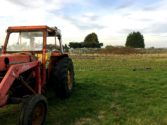Rachel from our growing team explains all about the hungry gap! This was originally posted in March 2019.
What is the Hungry Gap?
For those of us growing vegetables in the British climate, there is a period in spring between April and June where there is very little fresh produce coming out of the ground – known to gardeners and growers as the hungry gap. This is because the previous season’s crops have finished, and the new season’s crops aren’t ready yet.
Over-winter crops are planted at the end of the summer. They have a flush of growth taking in the remaining heat and daylight in autumn, but slow dramatically and even stop growing through the depths of winter. We can harvest them (sparingly) through winter, and into spring when they have a growth spurt again. Warmer weather in spring sees the end of these crops, as they respond by going to seed (which means we can no longer harvest them). The earliest crops for the next season can’t be planted until the weather starts to warm and dry out the ground, and aren’t ready to harvest until June. Crops that were harvested in the autumn such as onions or carrots and have been kept in storage might begin to run out, although this depends on how large the harvest was and how much demand there has been for them.
The length of the hungry gap can vary depending on the weather at the beginning of the year. The spring weather determines how long the over-winter crops will hold before going to seed. Tractor cultivations means farmers need to wait until the ground is dry enough to rotavate, as taking heavy machinery onto wet ground damages the soil structure by compacting it.
The Hungry Gap at Sutton Community Farm
To supply fresh produce in the winter and try to minimise the hungry gap at Sutton Community Farm, we grow purple sprouting broccoli, leeks and broad beans outside.
We harvest leeks from January, until they start to bolt (go to seed) around April. Purple sprouting broccoli is a welcome fresh green in March and can last into May depending on the temperatures (as high temperatures encourages them to open into their yellow flowers rather than stay as a sprouting head). The first spring crop to come in is the broad beans. If grown over winter like ours, they can be very early and can help to bridge the hungry gap.
Overwinter produce in the polytunnels (spinach, pak choi, chard, spring shallots and mixed salad leaves) gives us leafy greens through the winter. However, there is only so much we can grow because cool temperatures and fewer daylight hours results in slow plant growth.
This year we have already been able to prepare the ground ready for planting thanks to the false spring we had in mid February. This means we can get our first crops in on time – very handy for us! But it is also quite a worrying indicator of our increasingly erratic climate, especially when we consider at the same time last year we were in the grip of the Beast from the East.
Other farms in the UK grow more overwinter brassicas such as cabbages, cauliflowers and ‘hungry gap kale’- a variety that lives up to its name! Farms with good storage facilities and space to grow potatoes and root vegetables efficiently can store these crops overwinter, as well as winter squash, which can provide those starchy staples we need in the winter months and into spring. At Sutton Community Farm we usually sell all of our winter squash by Christmas, as we don’t have the facilities to store them for much longer.
Where does our fresh produce come from in the Hungry Gap?
During the hungry gap we still strive to fill our VegBoxes with as much UK produce as possible. When supplies run out, importing overland from Europe is the best way for us to provide fresh leafy greens and diversity in the VegBoxes. The alternative – heating and lighting greenhouses or polytunnels to produce outside the season in the UK or abroad – is far more energy intensive and therefore not a good option for sourcing vegetables sustainably. Before imports like we have today, people would quite literally have been hungry during the hungry gap, eating preserves and pickles as they waited eagerly for the fresh produce of spring to arrive!
Rachel Clark
Grower, 2019
